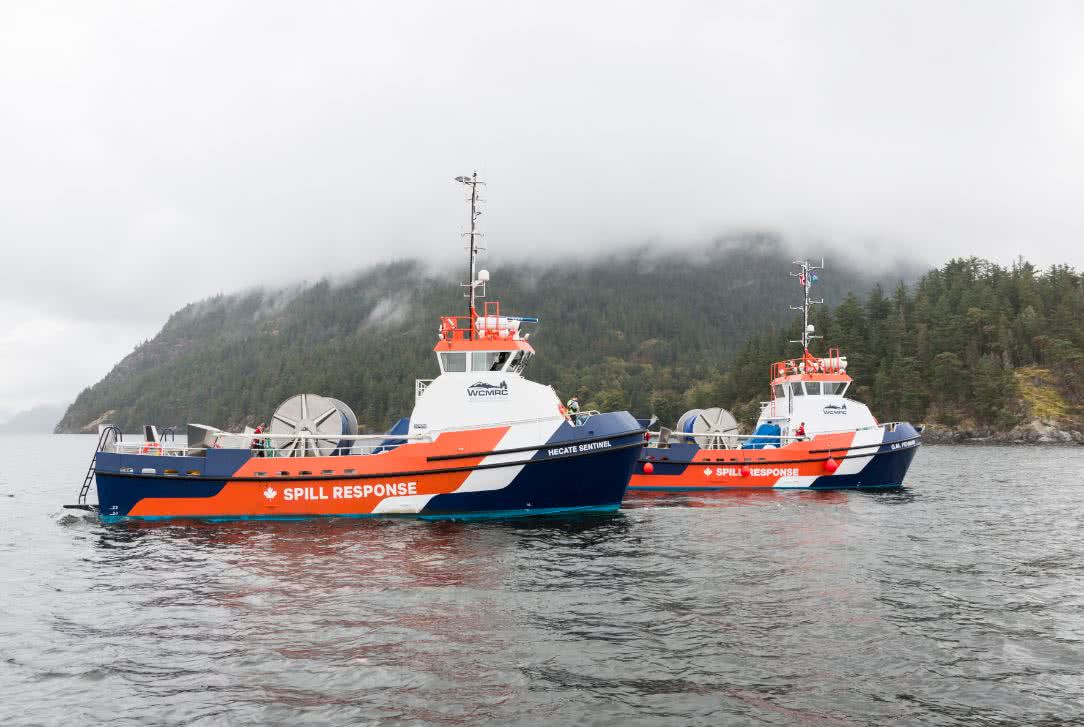If a diluted bitumen spill happens on Canada’s West Coast, is it possible to clean it up?
Yes.
Yes, it is. We know that because we have already successfully responded to a diluted bitumen spill in these waters. It’s what we continue to train and prepare for every day.
In 2007, Western Canada Marine Response Corp. (WCMRC) was activated to respond to an oil spill in Burrard Inlet after a backhoe ruptured a pipeline beneath Barnet Highway in Burnaby. The pipeline rupture primarily released oil on-land, but approximately 100,000 litres of diluted bitumen drained into a network of storm drains that empty into the Inlet.
WCMRC dispatched vessels to the site within an hour of activation. Our crews deployed boom to protect the shoreline area and contain the oil, skimming it off the surface of the water. Identification of oiled shorelines was initiated by shoreline cleanup teams comprised of First Nations, Port of Vancouver representatives, and federal, provincial and municipal officials. These teams established cleanup methods, set priorities and recovery endpoints, and began their work. The on-water response operation was completed within days, while shoreline cleanup continued for six weeks. Short and long-term environmental monitoring programs were established by stakeholders and recovery endpoints were met, confirming no long-term impacts to the affected area.
The Inlet Drive incident is the largest spill WCMRC has cleaned up on Canada’s West Coast—it was a diluted bitumen spill, and 95 per cent of the product was recovered. This despite the oil having picked up some sand, soil and other debris on its way to the Inlet.
In Canada, marine spill response falls under the jurisdiction of the federal government. Transport Canada oversees the regime, setting the regulatory structure, managing the certification program for response organizations, and enforcing standards and legislation. Environment and Climate Change Canada and the Department of Fisheries and Oceans ensure the science supporting the regime reflects the realities of the products traveling over our land and through our waters.
Part of their work is to commission and conduct studies in conjunction with other federal departments, universities and scientific bodies, such as the International Institute for Sustainable Development’s Experimental Lakes Area in Northeastern Ontario. As federal Minister of Environment and Climate Change Catherine McKenna recently pointed out, the government has produced more than 60 peer-reviewed publications since 2013 focused on the science of diluted bitumen spills. And the findings align with our experience.
Diluted bitumen’s density is lighter than the density of sea water, similar to most other medium to heavy crude oils. This means diluted bitumen floats when spilled in the ocean. This was our experience during the Inlet Drive spill and has also been confirmed in numerous tests, including a 2016 Natural Resources Canada study which concluded diluted bitumen would float in sea water for up to three or four weeks, even in rough conditions.
And, like most medium to heavy crude oils released into the sea, diluted bitumen can be recovered using a variety of skimmer systems, such as those employed by WCMRC. As tides, currents, turbulence, temperature and wave action weather the oil, the viscosity of the product increases. However, skimmers designed for more viscous oils—such as brush, belt and mechanical systems—as well as sorbent booms and sorbent pads, continue to effectively recover weathered oil in these conditions.
As a certified marine response organization, WCMRC must demonstrate its ability to adhere to the tiered response standards established by Transport Canada for our coastal waters. These standards define the timeframe within which WCMRC must respond to a spill of a specific quantity. They include the number of metres of shoreline that must be treated daily during a response and the number of days in which on-water recovery operations must be completed.
New marine spill response enhancements for the Trans Mountain pipeline expansion, should it proceed, will reduce response times by more than half the existing planning standards and double existing response capacity. The enhancements include the creation of six new response bases along our shipping lanes, doubling WCMRC’s fleet to more than 80 vessels, and adding more than 120 personnel to response crews. These dedicated resources will be staged at strategic coastal locations in the Salish Sea, and will be available to the entire marine community—not only to Trans Mountain tankers.
The singular tenet of spill response across the globe is to mitigate the damage to the environment by ensuring a swift and effective cleanup operation that removes the oil as quickly as possible. This is true during a diluted bitumen spill, and the techniques are equally effective. Responders employ a variety of detection and recovery systems to protect sensitive areas and shorelines, clean up the product, and protect people and wildlife from harm.
There hasn’t been a single spill incident involving a tanker on Canada’s West Coast in the 40-plus years WCMRC has been operating here. And while every oil spill is different, what never changes is the dedication to preparedness by response organizations, governments, First Nations and other stakeholders. In Canada we are committed to ensuring the highest standards of marine response are employed in every operation undertaken. Research has reinforced WCMRC’s experience and our existing strategies and tactics to protect Canada’s West Coast and the people and wildlife that live here. If diluted bitumen spills again, we are prepared.

